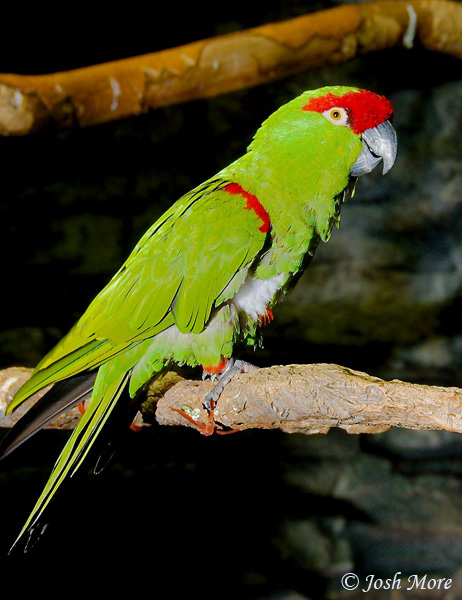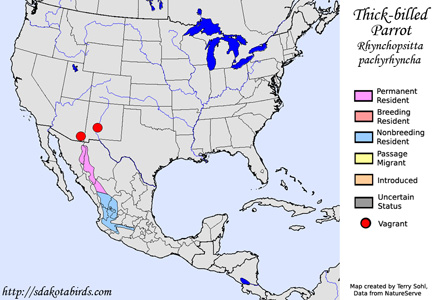| Length: 15-17 inches | Wingspan: 24-26 inches | Seasonality: Non-resident in South Dakota |
| ID Keys: Bright green overall, brilliant red forehead and eyebrow, brilliant red shoulder patch | ||
 The
Thick-billed Parrot is a brilliantly colored bird currently found only in
western Mexico. In the 1800s the species was known as being relatively
common in parts of southern Arizona and New Mexico, with reports also coming
from far western Texas. Along with the now extinct
Carolina Parakeet, they were one of
only two native parrot species to be found in the United States. They were
considered summer visitors in the southwestern U.S, but they did breed in
the U.S. before moving southward into Mexico for the winter. The last
verifiable reports of Thick-billed Parrots in the United States came from
the mid-1930s in the Chiricahua Mountains of southeastern Arizona.
Scattered, unverified reports and rumors have occurred since then, including
a well-seen and documented bird in New Mexico in 2003. However, the New
Mexico records committee didn't accept the sighting as that of a wild bird,
given the possibility that it may have represented an escaped captive bird.
The
Thick-billed Parrot is a brilliantly colored bird currently found only in
western Mexico. In the 1800s the species was known as being relatively
common in parts of southern Arizona and New Mexico, with reports also coming
from far western Texas. Along with the now extinct
Carolina Parakeet, they were one of
only two native parrot species to be found in the United States. They were
considered summer visitors in the southwestern U.S, but they did breed in
the U.S. before moving southward into Mexico for the winter. The last
verifiable reports of Thick-billed Parrots in the United States came from
the mid-1930s in the Chiricahua Mountains of southeastern Arizona.
Scattered, unverified reports and rumors have occurred since then, including
a well-seen and documented bird in New Mexico in 2003. However, the New
Mexico records committee didn't accept the sighting as that of a wild bird,
given the possibility that it may have represented an escaped captive bird.
Habitat loss is thought to be the primary reason for the decline of the Thick-billed Parrot, not only in its former range in the United States, but also in Mexico. The species is heavily dependent upon pine seeds for food, and the use of old-growth pine trees for building nesting cavities. While much of their former range still has a forest cover today, the structure of those forests is dramatically different than what was there historically. Old-growth forests, with large pine trees capable of producing heavy pine seed crops and capable of supporting nesting cavities, are gone throughout the vast majority of its former range. The species has struggled to adapt as a result.
Given their former occupancy in parts of the United States, efforts were made to reintroduce the species into southeastern Arizona in the 1980s. These efforts ultimately failed, and reintroduction attempts were halted by the early 1990s. 88 Thick-billed Parrots were released during that time, but the last time one of the introduced birds was seen was 1995. The change in forest structure in the region may have made Thick-billed Parrots more susceptible to predation by raptors, as without the old-growth forests, more forest edge habitat and open forest was available. Northern Goshawks in particular were found to feed on the reintroduced parrots. The reintroduction attempts were also criticized for their methodology. Many of the birds were former captives that had never been raised in the wild, and thus lacked social and survival skills. Others were birds obtained from the illegal pet trade. Given the highly social nature of the species, it was thought that the release of individual birds or pairs, without social bonds (or even social and survival skills, in the case of the former captive-raised birds), hindered the establishment of socially bonded, successful breeding and feeding flocks. It is thought that a successful reintroduction attempt would necessarily require the simultaneous release of a relatively large number of (preferably) previously bonded birds, an endeavor that's made extremely difficult given the decline of remaining wild birds in Mexico.
Habitat: Found in conifer and mixed forests in montane regions, at moderate elevations (from 1,200 to 3,200 meters). This may include pure pine or other conifer stands, or mixed pine / oak forests.
Diet: Feeds heavily on the seeds of conifers, particularly Mexican white pine (Pinus ayacahuite), but also the seeds of other conifers if available. They will also on occasion take other food items such as fresh buds of pines, acorns, fresh blooms and nectar, or nuts.
Behavior: Thick-billed Parrots are a very gregarious species, both during the breeding season and during the winter months. During the breeding season, they can often be found in loose colonies, with a number of nesting cavities located in relatively close proximity. Outside the breeding season, they move in sometimes moderately large flocks, moving from location to location in search of the best crops of pine seeds.
Nesting: Breeding is timed to occur with the arrival of the heaviest crops of pine seeds. Nesting occurs in the cavity of a large tree, typically an old-growth pine, but in some parts of their range, they will also use large aspen trees. The female lays between one and four eggs. She alone incubates them, but the male gathers food and delivers it to the female throughout the incubation period. The eggs hatch after about 4 weeks. The young typically don't fledge from the next until about 2 months after hatching.
Song: A variety of harsh, loud, rolling call that may sound like a series of human cackles. Click here to access the call of a Thick-billed Parrot.
Migration: Found in the higher elevations of the Sierra Madre Occidental during breeding. For the winter, nearly all birds move southward for the winter (see range map below). The species is also highly nomadic regardless of season, moving throughout their normal range in search of the best crops of pine seeds.
Interactive eBird map: Click here to access an interactive eBird map of Thick-billed Parakeet sightings
Similar Species: Most similar to the Red-crowned Parrot, a species native to eastern Mexico that has now become established within the U.S. in and around Los Angeles, San Diego, and the Rio Grande river valley on the Mexican border. Both species are green overall with a red forehead patch. The red is more extensive on the Thick-billed Parrot, and the Thick-billed Parrot has a red shoulder patch that's lacking on the Red-crowned Parrot.
Conservation Status: The IUCN lists the Thick-billed Parrot as "Endangered". It is likely that fewer than 2,000 individuals remain in the wild. Habitat change and degradation has been the major cause of the species decline. Thick-billed Parrots heavily utilized old-growth pine forests in the area. However, with active timber management, forests are often used as a crop in the region now, and the heavily managed forests are rarely allowed to reach the older growth stages that Thick-billed Parrots prefer. In the core of its range in the Sierra Madre Occidental, over 99% of the original old-growth pine forests are gone, and while a forest cover still exists in part of its range, the change in forest structure has taken a toll on the species.
The species is also occasionally taken as part of the illegal pet trade. The rarity of the species now may make Thick-billed Parrots more desirable for "collectors", even though they have generally not been well-regarded as domestic pets. They sometimes will become "tame", but breeding in captivity has proven to be extremely difficult, and their loud, raucous nature also makes them undesirable as pets. However, indications are that illegal pet trade activity has increased in recent years.
Further Information: 1) Cornell's NeoTropical Birds - Thick-billed Parrot
2) American Bird Conservancy - Thick-billed Parrot
3) WhatBird - Thick-billed Parrot
Photo Information: Photo by Josh More - Photo licensed under Creative Commons Attribution NonCommercial NoDerivs 2.0 Generic License
| Click below for a higher-resolution map |
 |
| South Dakota Status: Non-resident in South Dakota |
Additional Thick-billed Parrot Photos (coming soon!!)
